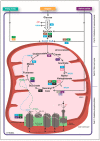Vitamins and Minerals for Energy, Fatigue and Cognition: A Narrative Review of the Biochemical and Clinical Evidence
- PMID: 31963141
- PMCID: PMC7019700
- DOI: 10.3390/nu12010228
Vitamins and Minerals for Energy, Fatigue and Cognition: A Narrative Review of the Biochemical and Clinical Evidence
Abstract
Vitamins and minerals are essential to humans as they play essential roles in a variety of basic metabolic pathways that support fundamental cellular functions. In particular, their involvement in energy-yielding metabolism, DNA synthesis, oxygen transport, and neuronal functions makes them critical for brain and muscular function. These, in turn, translate into effects on cognitive and psychological processes, including mental and physical fatigue. This review is focused on B vitamins (B1, B2, B3, B5, B6, B8, B9 and B12), vitamin C, iron, magnesium and zinc, which have recognized roles in these outcomes. It summarizes the biochemical bases and actions of these micronutrients at both the molecular and cellular levels and connects them with cognitive and psychological symptoms, as well as manifestations of fatigue that may occur when status or supplies of these micronutrients are not adequate.
Keywords: B vitamins; anemia; cognition; energy production; iron; magnesium; mental and physical fatigue; mood.; vitamin C; zinc.
Conflict of interest statement
A.-L.T., E.P., D.M. and C.S., are current employees of Sanofi. AS has not received fees or funding in relation to this publication. However, he has received research funding and/or consultancy/travel/speaker fees from several government research councils and several food and pharmaceutical companies, including a 2013/14 research grant from Sanofi, which was unrelated to this publication.
Figures


References
-
- EFSA Scientific Opinion on principles for deriving and applying Dietary Reference Values. EFSA J. 2010;8:1458.
-
- European Commission Commission Regulation (EU) No 432/2012 of 16 May 2012 establishing a list of permitted health claims made on foods, other than those referring to the reduction of disease risk and to children’s development and health. Off. J. Eur. Union. 2012;136:1–40.
-
- Griffiths J.K. Vitamin deficiencies. In: Magil A.J., Hill D.R., Solomon T., Ryan E.T., editors. Hunter’s Tropical Medicine and Emerging Infectious Disease. 9th ed. Elsevier; London, UK: 2013. pp. 997–1002.
Publication types
MeSH terms
Substances
LinkOut - more resources
Full Text Sources
Other Literature Sources
Medical

